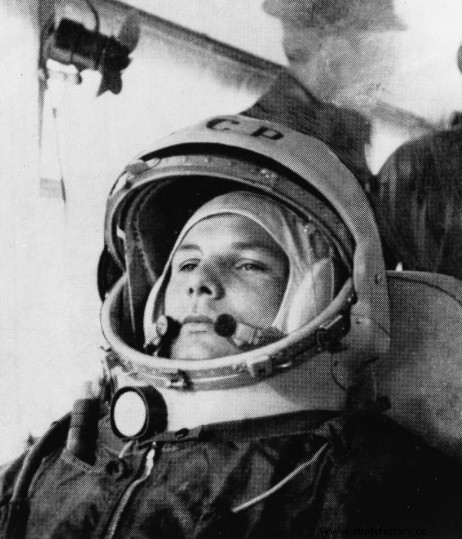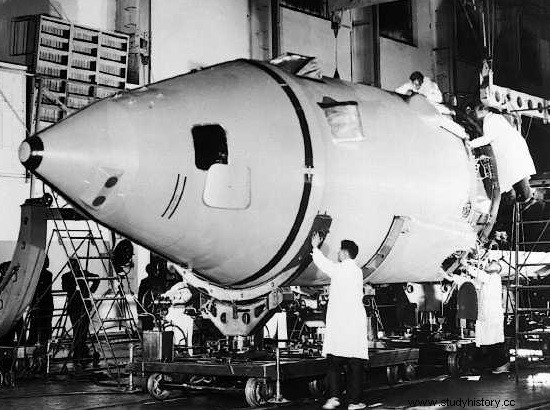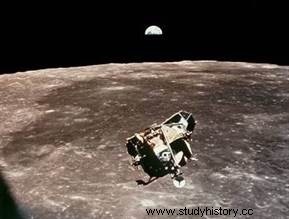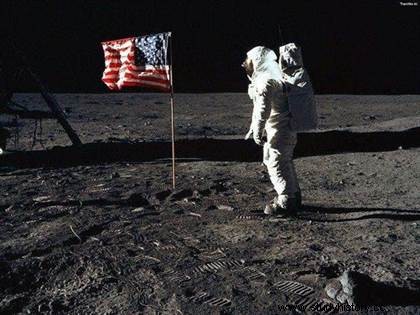 Cosmonaut Yuri Gagarin was the first man to fly in space on April 12, 1961. Launched into orbit aboard the Vostok 1 spacecraft, he circled the Earth once and landed after a 108-minute flight. Five centuries after Christopher Columbus , between 1961 and 1981, man embarked on a new conquest, the greatest ever undertaken:that of Space. Mysterious, cold and still very little known today, Space fascinates. From the first orbiting of a manned capsule to the launch of the first real spacecraft, 20 years of exploits have made a whole generation dream.
Cosmonaut Yuri Gagarin was the first man to fly in space on April 12, 1961. Launched into orbit aboard the Vostok 1 spacecraft, he circled the Earth once and landed after a 108-minute flight. Five centuries after Christopher Columbus , between 1961 and 1981, man embarked on a new conquest, the greatest ever undertaken:that of Space. Mysterious, cold and still very little known today, Space fascinates. From the first orbiting of a manned capsule to the launch of the first real spacecraft, 20 years of exploits have made a whole generation dream.
Man sets out to conquer space
Nearly two millennia after the first writings of Lucien of Samosata , who had imagined a wind of such force on the Mediterranean that a ship had ended up reaching the Moon, and about four centuries after the stories of French and English writers imagining a transport by Balloons, the first rockets worthy of the name were built in 1937 and launched at the end of 1942.
Of course, not to go to the Moon, but to cross the Channel. But the step has been taken and for the first time, in this second half of the 20th century, Man will really be able to launch himself in the direction of the sky.
And no more wondering if, like in the Middle Ages, going to Space could displease the church; the Conquistadors of the Void take advantage of the rivalry between the two great powers of the moment to settle in their capsules and face, serenely or with fear in their stomachs, the enormous risk of never coming back, ready for anything to be the first to overcome weightlessness.
First man in space:Yuri Gagarin
 In the midst of the Cold War, the Russians are the first to send an artificial satellite into orbit around the earth with Sputnik in October 1957. On April 12, 1961, less than four years after the "little beeping ball" was sent, Yuri Gagarin circled the Earth aboard the Vostok 1 spacecraft and achieves the first manned flight in history. He remains 1 hour 48 minutes in space, before descending to Earth. Having become a Hero of the Soviet Union, he would later be assigned to the new Soyuz spacecraft program, but would never be allowed to return to space. He died accidentally in 1968 on board a MIG, which unfortunately deprived him of the spectacle of the conquest of the Moon.
In the midst of the Cold War, the Russians are the first to send an artificial satellite into orbit around the earth with Sputnik in October 1957. On April 12, 1961, less than four years after the "little beeping ball" was sent, Yuri Gagarin circled the Earth aboard the Vostok 1 spacecraft and achieves the first manned flight in history. He remains 1 hour 48 minutes in space, before descending to Earth. Having become a Hero of the Soviet Union, he would later be assigned to the new Soyuz spacecraft program, but would never be allowed to return to space. He died accidentally in 1968 on board a MIG, which unfortunately deprived him of the spectacle of the conquest of the Moon.
The Americans, annoyed, send their side Alan Shepard perform a 15-minute jump into the cosmos (but without orbiting) aboard the Mercury “Liberty 7” cabin, on May 5, 1961. It will be necessary to wait for John Glenn, on February 20, 1962, to circumnavigate the Earth three times aboard the "Amitié 7" cabin.
Finally, the first woman in space is also Soviet:Valentina Tereshkova completed 48 orbits aboard Vostok 6 from June 16 to 19, 1963.
First spacewalk
This exploit goes to Alexis Leonov who spends 10 minutes outside the Voskhod ship on March 2, 1965, swimming in the sidereal vacuum, cold and silent. Edward White follows him three months later for the Americans, floating for 20 minutes out of his Gemini 4 cabin.
First loss on a space mission
Vladimir Komarov, in April 1967, killed himself on returning to Earth, after having circumnavigated it 17 times aboard Soyuz 1. His parachute flared up. .. An asteroid will be named in his name to honor his memory.
First man on the Moon
 For the first time, NASA first achieves a major feat:Neil Armstrong, July 20, 1969 , is the first man to walk on the moon and leaves his mark on the ground of the star. The Soviets, exhausted by 10 years of fierce struggle, will never achieve the same feat and will concentrate on their space station project.
For the first time, NASA first achieves a major feat:Neil Armstrong, July 20, 1969 , is the first man to walk on the moon and leaves his mark on the ground of the star. The Soviets, exhausted by 10 years of fierce struggle, will never achieve the same feat and will concentrate on their space station project.
First space station
April 19, 1971, Salyut 1 is put into orbit using a Proton rocket. It is visited by two Soyuz spacecraft. The first, Soyuz 10 (April 23-25), cannot dock with the station and is forced to return to Earth. It was finally Soyuz 11 which successfully docked on 7 June. On board, Georgi Dobrovolski, Viktor Patsayev and Vladislav Volkov remain in orbit for a total of 23 days.
Man is no longer satisfied with crossing Space:he remains there. Unfortunately, the three cosmonauts lose their lives when they return to Earth, following a depressurization.
First international spaceflight
Sign of relaxation between the two blocks, the Apollo-Soyuz mission of July 1975 sees an American spacecraft docking with a Soviet vessel after a rendezvous in orbit. Americans T. Stafford, V. Brand and D. Slayton meet A. Leonov and V. Kubasov.
First reusable rocket
The American Space Shuttle Columbia was launched on April 12, 1981, twenty years to the day after the flight of the first man in space . It is the first craft of its kind, capable of carrying large satellites into low orbit and, eventually, bringing them back to Earth.
And it is ultimately, to date, the only one of its kind despite many similar projects including the famous Buran (USSR) and the very ambitious Hermès (CNES then ESA). With this vehicle, Man definitively masters the immediate Space of the Earth.
Other conquests await...
The Universe, a new environment for Man
Before the first humans were sent into space, scientists were somewhat worried, because they did not know what effects spaceflight would have on the organism and the psyche. The astronauts indeed pass from immobility, on the launch platform, to the speed of 28,000 km/h in less than ten minutes. The acceleration of a rocket sometimes reaches values at the limit of the bearable for a trained individual, who can then weigh almost ten times its normal weight. Then there is weightlessness, a feeling that we do not know on Earth, and which can cause disorders.
 In low orbit around the earth, day and night repeat every hour and a half and no longer every 24 hours. There is no more air to intercept meteorites or filter out dangerous radiation from the Sun and, contrary to what science fiction movies may suggest, there is no noise .
In low orbit around the earth, day and night repeat every hour and a half and no longer every 24 hours. There is no more air to intercept meteorites or filter out dangerous radiation from the Sun and, contrary to what science fiction movies may suggest, there is no noise .
Finally, on the way back, the spacemen must once again withstand strong decelerations and cross a real inferno, because their space cabin is increased to more than 1500 °C and could burn like a meteorite.
In a quarter of a century of spaceflight, considerable progress has been made in the field of spacesuits, as in that of comfort on board spacecraft. The suits thus become light and flexible; without being great food, we eat almost normally in space, and the accelerations at launch have been reduced. Cosmonauts lived for 7 months around the Earth, in weightlessness, aboard the Soviet Salyut 7 orbital station. the plane. Later, tourists will leave elsewhere in their turn...
The Moon, constantly revisited
Before going to the Moon himself, and even after, Man sent his robots there. Here are a few dates of these explorations "by proxy" which have contributed in a beautiful way to the conquest of the Star that the human being has spent his entire existence contemplating.
- September 14, 1959 :Luna 2 (U.R.S.S.) was the first probe to hit the Moon.
- October 4, 1959 :the U.S.S.R. launched Luna 3. This probe flew over the Moon and took the first photographs of its far side.
- July 28, 64 :Ranger 7 (U.S.A.) transmitted 4000 photos by radio, during its free fall towards the Moon.
- February 3, 1966 :the first spacecraft to land smoothly on the Moon was Luna 9 (U.R.S.S.). The capsule landed on the star and sent images of the ground for three days.
- March 31, 1966 :launch of Luna 10 (U.R.S.S.):this is the first probe to orbit the Moon.
- August 1966 to August 1967 :the United States has placed five “Lunar orbiters” in orbit around the Moon. Their mission was to photograph the star from every angle, in order to establish maps allowing them to choose the landing sites for future Apollo missions.
- Surveyor probes (U.S.A.) soft-landed on the Moon between May 1966 and January 1968. There were five successful missions out of seven attempts. The purpose was to take pictures of the surface and perform chemical analyzes of the soil.
- Explorer 35 (U.S.A.) orbited the Moon on July 22, 1967 to measure its magnetic field.
- The U.S.S.R. launched Luna 16 on September 12, 1970 . The probe landed on the Moon eight days later to collect 100 grams of dust and automatically return to Earth on September 24.
- Luna 17 (U.R.S.S.), launched November 10, 1970 , landed softly on the Moon seven days later. She dropped off a remote-controlled vehicle there, the Lunok-hod 1.
To go further on the first man in space
- History of the Space Conquest, by Jean-François Clervoy. De Boek, 2017.
- Gagarin or The Russian Dream of Space, by Yves Gauthier. Ginkgo, 2015.
- Monsieur Gagarin, by Marie-Michèle Martinet. Gallimard, 2011.
- 100 misconceptions, untruths and unusual facts about the conquest of space. The Archipelago, 2019.
